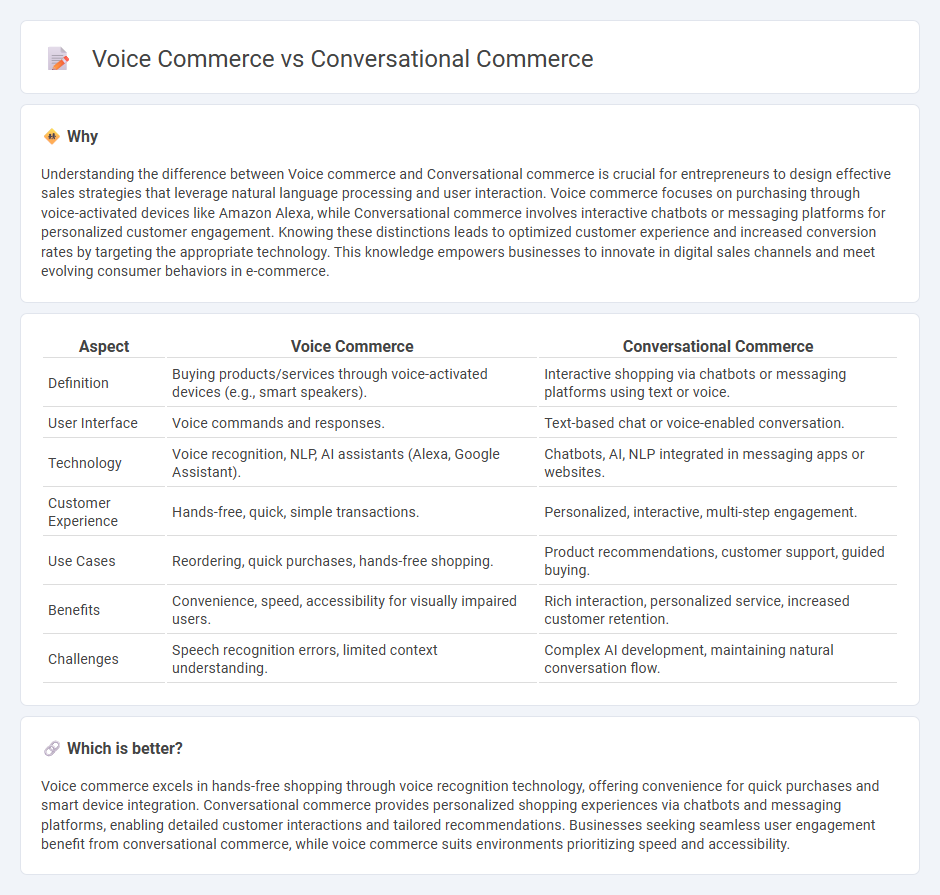
Voice commerce leverages voice recognition technology to enable consumers to make purchases using spoken commands, creating a hands-free shopping experience. Conversational commerce involves interactive dialogue between customers and businesses through chatbots or messaging platforms, allowing personalized assistance and product recommendations. Explore the key differences and business advantages of voice commerce versus conversational commerce to optimize your entrepreneurial strategy.
Why it is important
Understanding the difference between Voice commerce and Conversational commerce is crucial for entrepreneurs to design effective sales strategies that leverage natural language processing and user interaction. Voice commerce focuses on purchasing through voice-activated devices like Amazon Alexa, while Conversational commerce involves interactive chatbots or messaging platforms for personalized customer engagement. Knowing these distinctions leads to optimized customer experience and increased conversion rates by targeting the appropriate technology. This knowledge empowers businesses to innovate in digital sales channels and meet evolving consumer behaviors in e-commerce.
Comparison Table
| Aspect | Voice Commerce | Conversational Commerce |
|---|---|---|
| Definition | Buying products/services through voice-activated devices (e.g., smart speakers). | Interactive shopping via chatbots or messaging platforms using text or voice. |
| User Interface | Voice commands and responses. | Text-based chat or voice-enabled conversation. |
| Technology | Voice recognition, NLP, AI assistants (Alexa, Google Assistant). | Chatbots, AI, NLP integrated in messaging apps or websites. |
| Customer Experience | Hands-free, quick, simple transactions. | Personalized, interactive, multi-step engagement. |
| Use Cases | Reordering, quick purchases, hands-free shopping. | Product recommendations, customer support, guided buying. |
| Benefits | Convenience, speed, accessibility for visually impaired users. | Rich interaction, personalized service, increased customer retention. |
| Challenges | Speech recognition errors, limited context understanding. | Complex AI development, maintaining natural conversation flow. |
Which is better?
Voice commerce excels in hands-free shopping through voice recognition technology, offering convenience for quick purchases and smart device integration. Conversational commerce provides personalized shopping experiences via chatbots and messaging platforms, enabling detailed customer interactions and tailored recommendations. Businesses seeking seamless user engagement benefit from conversational commerce, while voice commerce suits environments prioritizing speed and accessibility.
Connection
Voice commerce and conversational commerce are interconnected through their reliance on natural language processing and AI-driven interfaces that enable seamless customer interactions. Voice commerce focuses on using voice commands to facilitate transactions via smart speakers and voice assistants, while conversational commerce extends this concept by integrating chatbots and messaging platforms for real-time dialogue and personalized shopping experiences. Both technologies enhance user convenience, increase engagement, and drive sales by providing intuitive, hands-free communication channels in the entrepreneurial landscape.
Key Terms
Chatbots
Conversational commerce leverages chatbots across messaging platforms to facilitate personalized shopping experiences through text, while voice commerce uses voice-activated assistants like Alexa or Google Assistant for hands-free purchasing. Chatbots enhance customer engagement by offering instant product recommendations, order tracking, and support in real-time, optimizing user interaction and driving sales. Explore how these technologies reshape retail strategies and boost consumer convenience.
Voice assistants
Voice commerce leverages voice assistants like Amazon Alexa, Google Assistant, and Apple Siri to enable hands-free shopping through natural language processing. Conversational commerce encompasses a broader range of interactions, including chatbots on messaging platforms such as WhatsApp, Facebook Messenger, and web-based live chats that facilitate personalized customer support and purchasing. Explore how voice assistants are transforming retail experiences and driving the future of voice commerce.
Natural language processing
Conversational commerce leverages natural language processing (NLP) to facilitate human-like interactions through chatbots and messaging apps, enhancing customer engagement and simplifying the shopping experience with personalized recommendations. Voice commerce utilizes NLP to interpret voice commands via devices like smart speakers, enabling hands-free shopping and quick transactions through speech recognition and intent detection. Explore more to understand how NLP-driven technologies transform the future of consumer interaction in digital marketplaces.
Source and External Links
What is Conversational Commerce? | CM.com Glossary - Conversational commerce enables consumers to shop and communicate with brands through messaging channels, voice, and chat, allowing customers to complete purchases within their preferred messaging apps like WhatsApp and Facebook Messenger.
What Is Conversational Commerce? Definition and Guide - Shopify - It involves chatbots, messaging apps, and voice assistants to facilitate personalized product recommendations, customer support, and secure purchases directly inside messaging platforms without needing to visit websites.
What is conversational commerce? Examples, types, + benefits - Conversational commerce uses messaging, chatbots, and conversational technology across customer touchpoints to improve shopping experiences by enabling real-time assistance, personalized recommendations, and payments through platforms like WhatsApp and WeChat.
 dowidth.com
dowidth.com